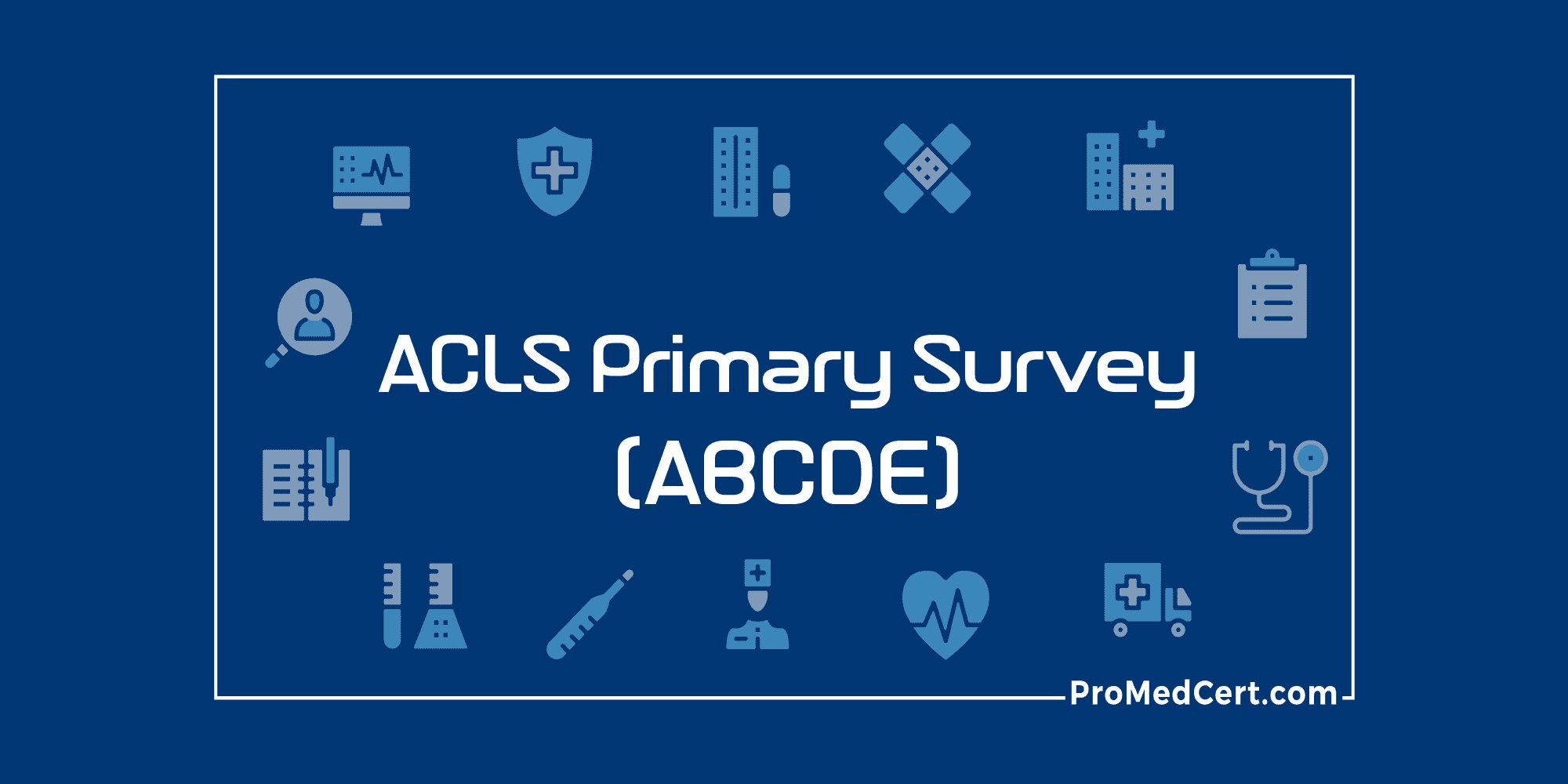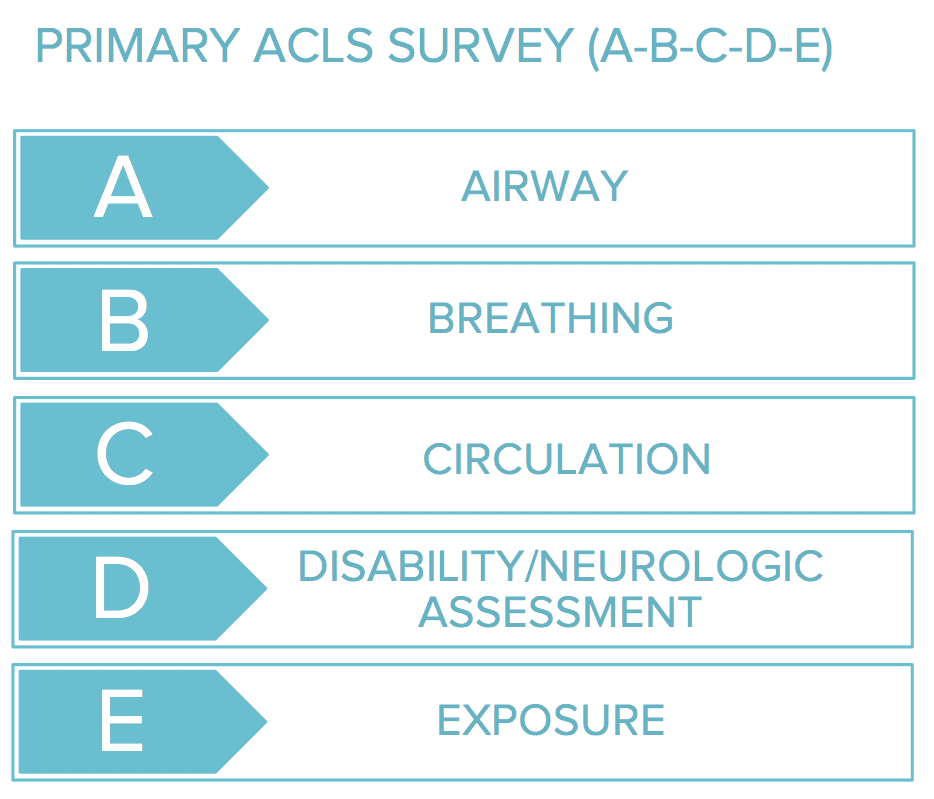Primary ACLS Survey (ABCDE)

The Primary Assessment is utilized either on an unconscious patient after a BLS assessment or on a conscious patient where the BLS assessment is not typically required (in the case of cardiac or respiratory arrest). The primary ACLS survey is included in every ACLS algorithm.
The Primary Survey uses the ABCDE acronym to systemize the assessment process (Check out the Ultimate List of ACLS Acronyms you need to know). The ABCDEs of the Primary Assessment are:

A. Airway Assessment
This step entails maintaining the airway of a patient and using advanced airway, if necessary. While using an advanced airway, you need to ensure the placement and security of the airway device. As with all of the steps of the Primary Assessment, you'll first assess and then take the appropriate next action.
Assessment Questions:
- Does the patient have a patent airway?
- Does the patient require an advanced airway (ET tube, etc.)?
- If an advanced airway has been placed, has proper placement been verified?
- If an advanced airway has been placed, is it secured?
Assessment Actions:
-
Maintain airway patency. If you don’t believe advanced airway is needed at the time (and it is more critical to focus on chest compressions), maintain the airway patency in unconscious patients by using:
- Head tilt - chin lift
- Oropharyngeal airway (OPA)
- Nasopharyngeal airway (NPA)
-
Use advanced airway if needed. If the above methods are not adequate and advanced airway is needed, maintain the airway patency in unconscious patients by using:
- Endotracheal airway- Keep in mind, placing an endotracheal tube requires ceasing chest compressions. You may want to consider waiting until the initial CPR is conducted.
- Laryngeal mask airway
- Esophageal tracheal tube
- Laryngeal tube
-
Confirm the placement of advanced airway. You can confirm placement by:
- Physical examination
- Quantitative waveform capnography
-
Secure advanced airway device. Ensure the device is secure to prevent any dislodgement.
-
Monitor Airway Placement. Continue to monitor airway during resuscitation using quantitative waveform capnography.
B. Breathing Assessment:
This step entails providing supplemental oxygen to a patient and avoiding excessive ventilation. Adequacy of ventilation and oxygenation should be monitored throughout this step.
Assessment Questions:
- Does the patient need supplementary oxygen?
- Is ventilation adequate?
Assessment Actions:
- Avoid overventilation. Overventilation can result in gastric inflation and other various complications.
- Provide oxygenation when necessary.
- Administer 100% oxygen in cardiac arrest patients.
- If no cardiac arrest is observed, titrate oxygen to reach 94% SaO2 (oxygen saturation) or more by pulse oximetry.
- Monitor patient oxygenation and ventilation. Utilize the following indicators to determine whether proper oxygenation and ventilation are occurring:
- Quantitative waveform capnography
- SaO2 (Oxygen Saturation)
- Chest movement (the rise and fall of the chest, indicating breaths)
- Cyanosis - bluish discoloration of the skin
C. Circulation Assessment:
This step entails gaining IV access, providing necessary fluids, attaching ECG leads, monitoring arrhythmias and defibrillation, if needed.
Assessment Questions:
- Check your chest compressions - are they effective?
- Can you identify the cardiac rhythm?
- Is there an indication for defibrillation, cardioversion, or pacing?
- IV access: Is it established? If not, IO access?
- Does the patient require volume resuscitation (hypotension/shock)?
- Are medications indicated to support blood pressure? What about for rhythm?
- Has the patient experienced the return of spontaneous circulation (ROSC)?
- If the patient has a pulse, is he or she stable?
Assessment Actions:
-
Continue to Monitor CPR Quality:
- Adequate by quantitative waveform capnography? If PETCO2 (Partial pressure of CO2 in exhaled air) is less than 10 mm Hg, improve the quality of CPR.
- Is there adequate intra-arterial pressure? If the diastolic pressure is less than 20 mm Hg compared to the systolic pressure, improve the quality of CPR.
-
Obtain IV/IO access and provide fluids if needed.
-
Attach monitor/defibrillator. Monitor for arrhythmias or cardiac arrest rhythms.
-
Defibrillation/Cardioversion
-
Check for any perfusion issues.
-
Check temperature and glucose.
-
Give appropriate drugs for rhythm and blood pressure management.
D. Disability/Neurologic Assessment
This step entails performing a broad neurological assessment which includes checking for responsiveness, degree of consciousness, and pupillary response. Use the AVPU acronym for reference: Alert, Voice, Painful, Unresponsive.
Assessment Question:
- What is the neurologic status: responsiveness, consciousness, pupils?
Assessment Actions:
- Check for neurological function.
- Assess for responsiveness, levels of consciousness, and pupil dilation.
- Use the AVPU mnemonic to quickly measure alertness:
- A. Alert (fully alert but not necessarily oriented)
- V. Voice (responds to voice)
- P. Pain (responds to painful stimuli)
- U. Unresponsive
E. Exposure Assessment
Perform physical exam. Remove clothing so that you can conduct a full visual assessment. Pay attention for signs of trauma, bleeding, burns, markings, or medical alert bracelets.

